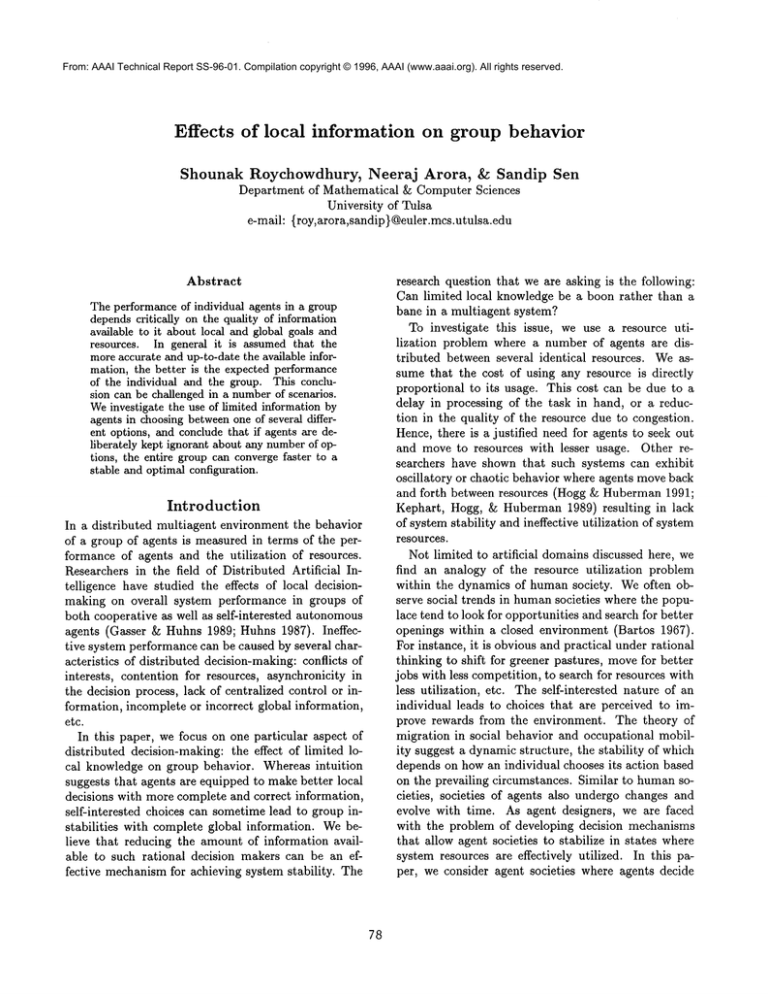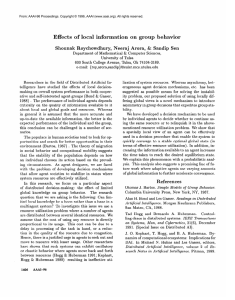Effects of local information on ...
advertisement

From: AAAI Technical Report SS-96-01. Compilation copyright © 1996, AAAI (www.aaai.org). All rights reserved. Effects Shounak of local information on group behavior Roychowdhury, Neeraj Arora, &: Sandip Department of Mathematical & Computer Sciences University of Tulsa e-mail: (roy,arora,sandip)@euler.mcs.utulsa.edu Abstract The performanceof individual agents in a group dependscritically on the quality of information available to it about local and global goals and resources. In general it is assumed that the moreaccurate and up-to-date the available information, the better is the expected performance of the individual and the group. This conclusion can be challenged in a numberof scenarios. Weinvestigate the use of limited information by agents in choosingbetweenone of several different options, and conclude that if agents axe deliberately kept ignorant about any numberof options, the entire group can converge faster to a stable and optimal configuration. Introduction In a distributed multiagent environment the behavior of a group of agents is measured in terms of the performance of agents and the utilization of resources. Researchers in the field of Distributed Artificial Intelligence have studied the effects of local decisionmaking on overall system performance in groups of both cooperative as well as self-interested autonomous agents (Gasser & Huhns 1989; Huhns 1987). Ineffective system performance can be caused by several characteristics of distributed decision-making: conflicts of interests, contention for resources, asynchronicity in the decision process, lack of centralized control or information, incomplete or incorrect global information, etc. In this paper, we focus on one particular aspect of distributed decision-making: the effect of limited local knowledge on group behavior. Whereas intuition suggests that agents are equipped to make better local decisions with more complete and correct information, self-interested choices can sometime lead to group instabilities with complete global information. Webelieve that reducing the amount of information available to such rational decision makers can be an effective mechanismfor achieving system stability. The 78 Sen research question that we are asking is the following: Can limited local knowledge be a boon rather than a bane in a multiagent system? To investigate this issue, we use a resource utilization problem where a number of agents are distributed between several identical resources. Weassume that the cost of using any resource is directly proportional to its usage. This cost can be due to a delay in processing of the task in hand, or a reduction in the quality of the resource due to congestion. Hence, there is a justified need for agents to seek out and move to resources with lesser usage. Other researchers have shown that such systems can exhibit oscillatory or chaotic behavior where agents moveback and forth between resources (Hogg & Huberman1991; Kephart, Hogg, & Huberman 1989) resulting in lack of system stability and ineffective utilization of system resources. Not limited to artificial domains discussed here, we find an analogy of the resource utilization problem within the dynamics of human society. Weoften observe social trends in humansocieties where the populace tend to look for opportunities and search for better openings within a closed environment (Bartos 1967). For instance, it is obvious and practical under rational thinking to shift for greener pastures, movefor better jobs with less competition, to search for resources with less utilization, etc. The self-interested nature of an individual leads to choices that are perceived to improve rewards from the environment. The theory of migration in social behavior and occupational mobility suggest a dynamicstructure, the stability of which depends on howan individual chooses its action based on the prevailing circumstances. Similar to humansocieties, societies of agents also undergo changes and evolve with time. As agent designers, we are faced with the problem of developing decision mechanisms that allow agent societies to stabilize in states where system resources are effectively utilized. In this paper, we consider agent societies where agents decide on their social mobility based only on their perception of the current state of the world. This assumption of relying only on the current state and ignoring the effects of past history on decision makingis also used in Markovian analysis (Howard 1971). This study attempts to verify the following conjecture: limited knowledge of the environment can be beneficial for an agent in comparison to complete global knowledge. We present a decision mechanism to be used by individual agents to decide whether to continue using the same resource or to relinquish it in the above-mentioned resource utilization problem. We show that a spatially local view of an agent can be effectively used in a decision procedure that produces stable allocation of agents to an optimal global state in terms of effective resource utilization. Experimental results show that increasing the information available to an agent increases the time taken to reach the desired equilibrium state. Weprovide a probabilistic analysis explaining this phenomena. Wefurther plan to study the effects of varying amounts of information on the convergence process of these agent groups. Related Resouces #1 #2 Agents ¯ ¯ ¯ ¯ #n ¯ Figure 1: Agents sharing resources. The Model In this section we present a simple model of agents sharing a set of identical resources as shown the Figure 1. There are m agents and n identical resources. At any time instant, an agent use only one resource, and over time tries to moveto a resource that is less used by other agents. In this study, we show that when an agent has less knowledge about the utilization of each resource in the resource set, the contention for resources decreases and results in quicker convergence to stable resource usage. At present we model the knowledge of an agent about the resources by using an r-window. An rwindow is a window through which an agent can see which of the resources amongthe resource set it should look for before making a decision. At each time step each agent has to make the following decision: whether it should continue to use the present resource or should it moveto another one with less utilization. If agent ak is currently using resource i, then it will consider a moveto one of the resources in it’s r-window(resource in the vicinity of the current resource). The model makes a few basic assumptions. We assume that that all resources are equivalent. Moreover, resources are neither introduced nor eliminated during the life time of agents. Similarly all agents remain active and they make their decisions synchronously. All agents retain the same r-window size during the process of decision making. The probability of an agent to shift from the current resource to another resource is inversely proportional to the difference of the usage of these two resource. Wenow discuss the decision procedure we use to determine the resource to be used by an agent in the next time step. It can be shown that a deterministic and greedy decision procedure of choosing the resource with the lowest utilization in the r-windowwill lead to system oscillations. Hence, we are motivated to use a probabilistic decision procedure. The particular procedure that we use first calculates the probability Work Hogg and Huberman (Hogg & Huberman 1991) have analyzed a resource utilization problem similar to the one mentioned in the previous section to study effects of local decisions on group behavior (Hogg Huberman 1991; Kephart, Hogg, & Huberman 1989). Kephart et al. (Kephart, Hogg, & Huberman 1989) showhow system parameters like decision rate can produce stable equilibria, dampedoscillations, persistent oscillations, or can burst into a chaotic regime. They also provide an analysis of how agents that monitor system behavior and accordingly adjust their performancecan bring the system closer to a stable behavior. Hogg and Huberman (Hogg & Huberman 1991) present a robust procedure for suppressing system oscillations using a reward mechanism based on performance. Weshare their motivation of achieving stability in a multiagent system when individual agents are making decisions based on self-interest. However, whereas they are interested in investigating decision procedures that lead to heterogeneity in agent types, we focus our efforts on identifying a simple decision procedure that can be used by all agents but wouldstill lead to stable systems. On another note, we are particularly interested in evaluating the effects of agent decisions based on limited system knowledgeon the stability of the system. Thus we have chosen to investigate systems with relatively larger number of resources as compared to others. 79 d w l i-2 i-1 i r-window =5 i+I i’2 ,c i+2 i-I i r-window =5 i+l i+2 Figure 2: Resource i has d agents more than every other resource in its r-window. Figure 3: Resource i has d agents less than every other resource in the r-window. of moving to each of the resources in the r-window, and then normalizes theses values by the corresponding sum. The probability of an agent that decides to continue to use the same resource i is given by: binomial distribution i with probability Pr(i, i). The expected value of X is therefore given by: fii q_,,,, (1) Var[X] = nPr(i, i)(1 Pr(i, i) 1 + vexp where ri is the number of agents currently using resource i (this is also the utilization of that resource), and v, c~, and ~ are control parameters. On the other hand, the probability of moving to another resource j # i is given by: 1fij = lr,_~_, ifjEWi~ri>rj, 1"4"1"exp 0 otherwise, (2) where Wi are the resources accessible to agent using resource i. Now, the probability that an agent ak occupying a resource i will occupya resource j in the next time step is given by normalizing the above terms: Pr(i,j)- (4) and the variance of X is given by: 1 = 1- E[X] = nPr(i, i), flj f J" (3) (5) Similarly, as the Figure 3 shows, the resource i is being less utilized when compared with its neighbors. Obviously there will be a tendency of an agent who is currently not using i to moveto resource i. Let Y be the random variable corresponding to the number of agents whowill moveinto resource i in the next time step. Therefore values for that Y follow a binomial distribution with the probability )--~j#~ Pr(j, i). Wecan also think of Y as a sum of several independent binomially distributed random variables, Yji, where Y corresponds to the number of agents who will move into resource i from resource j in the next time step. ]~i has an expected value of nPr(j, i) and a variance of aPt(j, i)(1 Pr(j, i) ). Therefore, th e expected values of Y is given by: E[Y] = E aPt(j, i). (6) And the corresponding variance is: Our conjecture for the behavior of the group is: the larger the r-window, the lesser is the stability of the system, and it takes more time to reach an optimal equilibrium state. This slower convergence can be explained by a probabilistic analysis. Consider a resource i which has higher load than the surrounding resources (as shown in the Figure 2). Wefurther assume that agents are using that resource at a given instance of time. Let X be a random variable corresponding the number of agents who will not leave the resource in the next time step. Therefore, values for X follow a Var[Y] = E nPr(j, i)(1 Pr(j, i) ). (7 Let us now analyze the implications of these analysis. Figure 4 plots the expressions in (4) and (5) different d values and different r-window sizes. Figure 4 reveals a very interesting phenomena. For large window sizes, the variance of the number of agents staying in the resource decreases as the difference between the utilization of the current resource usage and 8O d~l+. |=2~t ",, 2.5 l-3se "’, ",, :"-:-’::’-: .......... -.:2 ,;<~., ",.,,,, "’--,,. ,. \2,,. - "’~ ~ "., ¯,.., , ",, ’,, ¯ , ,, .,/ .,~\, ~. ,,, 1.5 "",d,~2 ""-.,~,, , ,. ~,, N ’,, ~’~ ",,. "., 10 r-window 12 14 16 0 "".. "’~o. "’.. "¢... ¯.......... --..<~. ......... ¯................ -’--:~=_’-~’:=.~’=~s ""’"= ...... ".................. ~-’-=z= 8 "~’~I ---4 "~, ...... -,... .... 0.5 6 , / \\ i///] ~,/" 4 "-. ",, i 4 2 i 16 r-window Figure 4: Expectation and variance of an agent staying in the current resource (corresponding to Figure 2), and l+d=lO. 120 ’ ’ ’ , ¢" d=8’ II0 ,~’’" /.’ I00: ,~ d=7 9O .f 2.5 = >d~l d=2 fl.I d=6 .ID dr3 80 8 70 6O 1.5 50 4O 30 20 I0 0 ,. "~’".."" A¢" ~¢ ............... d=3 ..:..’,..’..~" ,.,.-’ ................ . -~.......... ...:..-...’..~." ........x.’" ..-~ ....... ~;’~.’;.."" ~............. ..-~ ....... ta...... ~-’.[.............. d-2 . ..... - ....- ....... ~--_ ......................... ~:::....... ~--’",---4 n+"-= 6 t 8 9 , o I 10 r-window o I 12 : I ~dfle 14 / / .... 0.5 .,~..... Ac" ~" ..... d=7 if’-- ..... ........ ......... ...... df8. ":;:..-":= :~":’-’: ~-: +*’: ÷ ~;~:~.;_..-~:::~.,-::.-~= ...; .... , , 16 4 6 8 10 r-window 12 ...... , 14 + , 16 Figure 5: Expectation and variance of an ~gent movingto the less used resource (corresponding to Figure 3). the neighboring resource usages decreases. This means initially the agents will quickly spread out, but later it will have difficulty to converge whenall resources have roughly the same utilization. At this point high variance can again cause some imbalance in the resource usage. The situation is precisely the opposite for small windowsizes: here, the variance decreases with the decreasing difference betweenthe current and the neighboring resources. This meansthat there will be a relatively slower convergence towards a balanced distribution of agents to resources, but there is a continuing pressure towards more uniform distribution of agents to resources. This process is further helped by greater inertia of movingof the current resource at smaller r-window sizes as seen from expected number of agent plot in Figure 5. A similar phenomenais 81 observed in Figure 5 where we consider the variance in the numberof agents coming to a resource which is less utilized than the neighboring resources. These two figures give ~ moreformalexplanation of the faster convergence with smaller windows. Weare currently performing~ moredetailed ~nalysis of this phenomena. Results Weassume that the resources are arranged in a ring and each agent knows the number of agents using the resource it is using and the neighboring resources within the r-window to the left and right. Each time step consists of all agents making~ decision regarding which resource to use next. In Figure 6 we present experimental results with 63 agents using 9 resources. The d~ta for these plots are averaged over 10 random 1300 i I I I I investigations on the interplay between limited global knowledgeand group stability. Wediscuss some of our planned experiments below: 1200 I100 1000 9OO ~ 7o0 ~600 ~ 5oo 400 300 200 100 0 3 I 4 I 5 I 6 Windowsize I 7 I 8 9 Figure 6: Numberof steps to convergence for different R-windowsizes. initial assignments of agents to resources. Starting from r-windowsize of 3, as we increase the size of the window to 9, we observe that the system takes much more time on the average to stabilize. Figure 7 presents the number of agents occupying resource 1 at different time steps with r-window sizes of 3, 5, 7, and 9 respectively. These figures confirm our experimentation that together with taking more time to converge, the variation in the number of agents occupying a given resource is higher with the larger windowsize. Our initial experiments, therefore, suggest that agents converge to a stable state (which is also optimal because agents are equally distributed amongthe resources) in less number of time steps when they have relatively less global information. Adaptive agents: Counter to our normal expectations we have shown that it may be detrimental to search far and wide for the best opportunity if everyone is doing the same. In retrospective, an intelligent agent may adopt an adaptive policy of increasing its information windowuntil it senses an instability in the system (finds itself jumpingcontinuously from one option to another). At that point it may be prudent to reduce the information window. Adaptive policies may use specific dynamic learning strategies to handle specific problems. For instance, resource utilization problem might use a learning strategy which might not be suitable in a problem where communication is a critical. Graded movements: We can also model agents with graded inertia of rest. These agents prefer to shift to a nearer resource with less utilization rather than to a more distant resource with negligible utilization. A more uniform treatment of this approach would be to add a notion of stability to the probability calculation, i.e., the further off a resource is located from the current resource, the less will be the probability of making the movegiven the same difference in resource utilizations. Agents may have large window size, but is more and more reluctant to movefurther away from its current choice. This mechanism assumes a distance metric between choices. A simple extension to equation (1) can be shown as follows: fij Discussions To "bury the head in the sand" and ignore most of the information (in this case of using a small r-window) does not appear to be a sound principle in practice. However, to observe what neighbors are doing is may be good precept, but to base our decisions closely on what is happening anywhere in the whole wide world can be misleading at times, and can be detrimental in specific circumstances. One can easily find the effectiveness of such principles in daily chores of our lives. To name a few: a visit to a ticket counter, which highway to take to work, computational jobs waiting in various queues for their turn to get processed, etc. Similarly, we believe that a homogeneousagent society utilizing a set of limited resources might be able to utilize their resources efficiently by avoiding complete knowledgeabout the entire set of resource. Analyzing the data from these experiments suggests some further 82 = 01 1 l+r exp(ri--rJ)*SiJ ifj6Wi&n>rj, otherwise, (s) where $ij is the distance between resource i and resource j. Conclusions In this study we investigated the problem of resource utilization and global performance based on limited local information. The agents with a limited view of global scenario converged faster to optimal states. We provide a probabilistic analysis that sheds some light on this interesting phenomenon.Wealso identified future avenues of work that will produce adaptive agents which perform more effectively than agents with static strategies. Acknowledgments. This work has been supported, in part, by an NSFgrant IRI-9410180. 14 f 14 12 12 lO 10 8 4 20 ’ ’I000’oo 15 500 ’Time 2000 ’ 2500 ’ 3000 ;oo 3 4000 2 14 14 12 12 I0 I0 500 ’ I000 ’ 1 500 1000 1500 5’o0o’oo 2 25’o03000 ’ Tlm¢ 3 4000 3500 4000 8 2 0 500 I000 1500 2000 Tlme 2500 3000 3500 4000 2 0 2000 Time 2500 3000 Figure 7: System convergence with 63 Agents and 9 resources. From top left in clockwise order we have R-windows of 3, 5, 9, and 7 respectively. References for DAI. In Huhns, M. N., and Gasser, L., eds., Distributed Artificial Intelligence, volume2 of Research Notes in Artificial Intelligence. Pitman. Bartos, O. J. 1967. Simple Models of Group Behavior. NewYork, NY: Columbia University Press. Gasser, L., and Huhns, M. N., eds. 1989. Distributed Artificial Intelligence, volume2 of Research Notes in Artificial Intelligence. Pitman. Hogg, T., and Huberman, B. A. 1991. Controlling chaos in distributed systems. IEEE Transactions on Systems, Man, and Cybernetics 21(6). (Special Issue on Distributed AI). Howard, R. A. 1971. Dynamic Probabilistic Systems, Volume I: Markov Models. NewYork, NY: John Wiley ~ Sons, Inc. Huhns, M., ed. 1987. Distributed Artificial Intelligence. Morgan Kaufmann. Kephart, J. O.; Hogg, T.; and Huberman,B. A. 1989. Dynamics of computational ecosystems: Implications 83





